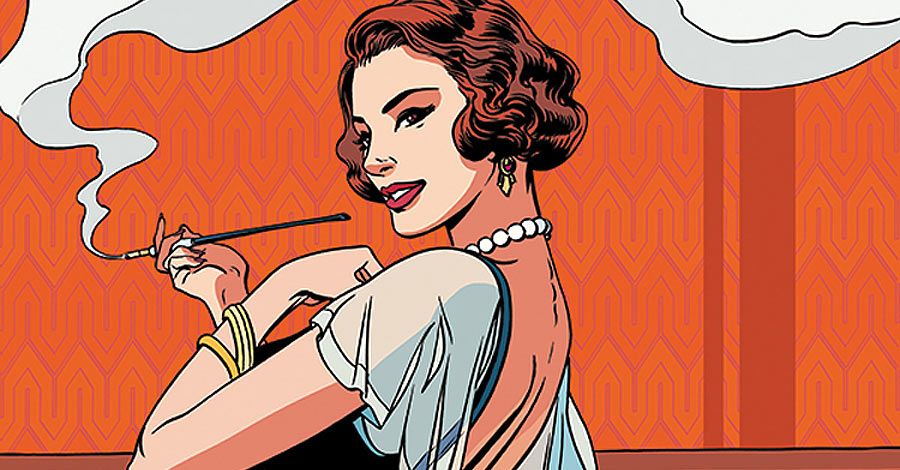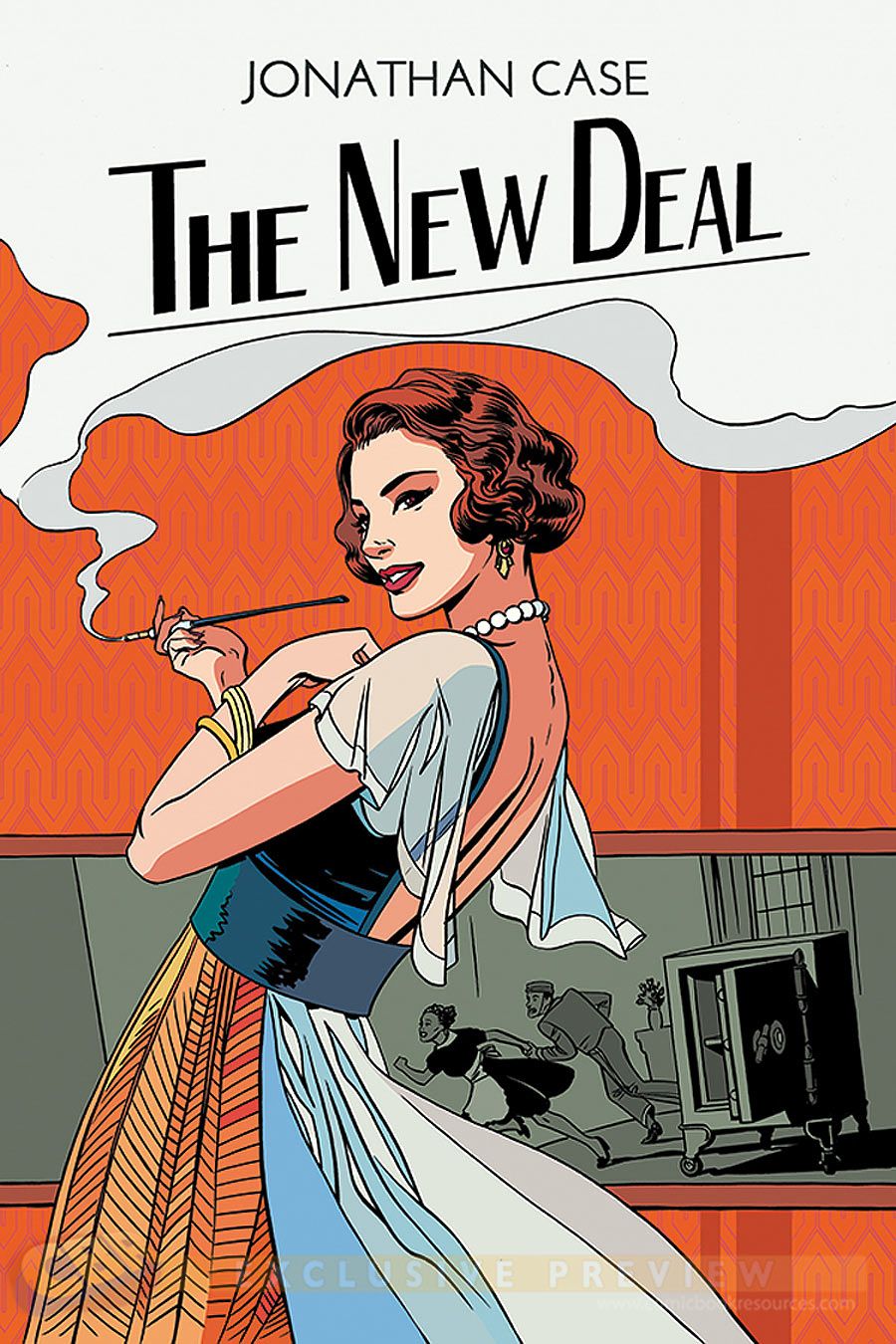Black and white classic American film featured some of the most iconic and famous movies of all time, and nobody knows that better than Eisner-winning artist Jonathan Case. A self-described fan of filmmakers like Billy Wilder ("Double Indemnity," "Sunset Boulevard"), Case's latest comic book project, "The New Deal," serves as an exhibit of his love for that era of American cinema. Coming September 2015 from Dark Horse Comics, "The New Deal" focuses on Frank, a bellhop, and Theresa, a maid, in their jobs at the historic Waldof-Astoria hotel in the mid-1930s. The story ramps up when a series of thefts occurs within the hotel, and the duo gets caught up in the middle of it. One part comedy, one part mystery and one part historical exploration, the OGN hopes to explore social and political themes of the era in a way that the original films never did.
In order to get a better idea of what to expect from "The New Deal," CBR spoke with Case about the development of the OGN, how his love of black and white American classic film led to development of the story, the challenges of returning to writing after drawing for other writers' scripts, researching the era through Sears catalogues and more.
CBR News: Jonathan, tell us a bit about "The New Deal." What's the core concept and how does the story kick off?
Jonathan Case: I love old movies, like Billy Wilder's stuff from the '30s and '40s, with that crackling dialogue. I've always wanted to do a book that would exhibit my love of the movies of that era, but also would allow me to explore parts of the social strata they typically did not. My lead characters are blue-collar -- they're a bellhop and a maid in the fanciest hotel in New York. It's a fun opportunity because of the comedy caper and crime aspect, it's seen through these characters that are on the outside of everything that's happening in the social scenes. It's a really interesting time period, set in 1935, 1936 and there's a wealth of economic and social conflicts, and exciting things happening at that time, like women's rights and race relations. Even though it's a comedy and it's played mostly for whimsical laughs, I get to explore some of those things I'm interested in.
Talk about your main characters, Frank and Theresa. How does their relationship build and what concepts are you able to explore through developing their relationship?
Well, Frank is an Irish-American kid -- a bellhop who is down on his luck, financially, but he's got a big heart and a lot of schemes and dreams. He's an idealist and just kind of a sweetheart, but he's always on the make, looking for the next opportunity. Theresa, his friend is a Black maid and she's the only black maid in all of the Waldorf-Astoria. She has an interesting story in that she befriends Frank -- and because he's this idealistic, loving guy, he doesn't think anything about the fact that it's awkward for other people in their workplace that they have this friendship.
He's really excited about her talent and her gifts because while she's a maid by day, she's also involved in the Orson Welles production of "Macbeth" that he mounted with an all Black cast. She's doing that, and Frank is really excited about that. There's all these difficult social situations that they find themselves in. When there's a theft in the hotel, all eyes turn on Theresa -- unfairly, of course -- and things get complicated, quickly. There's fun things to do to play against type, especially because The New Deal as it was going on politically and socially allowed populations of people -- like, the Black community in New York had The Harlem Renaissance at that time -- there was art and culture and all these things that were in high contrast to the rest of the world's expectations about African-American people.
That's a look into their world and their characters.
You mentioned you really love some of those old black and white classic films -- were there any specific influences that affected you as you started work on "The New Deal" OGN?
The word for this graphic novel for me is "glamour." I want you to dive in to the glamour and the sexy elegance. "Philadelphia Story," "Sunset Boulevard," to some extent "Some Like it Hot" -- Jack Lemmon-type characters. I love Jack Lemmon. I like the Jimmy Stewart/Katharine Hepburn relationship. I really want to have that kind of crackling dialogue. I'm no Billy Wilder, but I hope I can at least hold up some kind of image that will get people excited about the movies of that era, and the book for its own sake.
It seems like you've got a fair amount of expertise on this time period in American history. How much extra research went into developing the OGN?
I really enjoy the research -- I love buying old Sears catalogues. Almost all the comics I've worked in have been period pieces, so I'll buy a Sears catalogue from the 1930s or something and just go through it for visual reference. But I'll also think about what would be an interesting conflict for my characters to be in, what kind of political and social situations they would be aligning themselves with -- for me, it's like giving myself a history lesson. I was terrible about paying attention in high school, so it's fun for me to rediscover history through such an entertaining lens. It's sheer pleasure. I spend a lot of time on Wikipedia and in the library unearthing old books on how old hotels operated. How did a gigantic hotel in the 1930s get its dishes clean? There's all these fascinating things you just don't think about, but it's fun to enter in to that world.
I've only seen the cover, but it seems like you're having a lot of fun artistically about illustrating this period in American history in this context. How does this project present different challenges artistically than some of your other work, like "Batman '66" and "Green River Killer?"
That's a good question. For me, I've spent a number of years doing projects mainly for other writers. I've been illustrating graphic novels written by other folks, and so in a sense for me, it's kind of getting back to my storytelling roots. I came out with "Dear Creature" years ago and I feel like my storytelling vocabulary for that was very particular. "The New Deal" is a little bit different -- it's even yet more different than when you're working on somebody else's material. It was a little bit of a process of self-discovery.
With the artwork, I'm probably going to be drawing it a bit oversize again, like I did with "Dear Creature" so that I can capture more of the feel of comics from that era, because most of them were drawn oversize. That gives me a chance to draw less with my hand and more with my brain. I'm not worried about screwing up because I can just do these broad and elegant strokes, and when you reduce it down, it looks even better.
I don't have an accurate hand. I'm pretty expressionist when it comes to brushstrokes. I'll be working large and that allows me to really sink into the costumes and the characters. I want to get a lot more background details in to get that sense of place and glamour. That's my challenge: to make the world come alive in a bigger way than I have before.
What new challenges did writing and drawing this particular OGN present for you, rather than just drawing another writer's script?
I've discovered more and more about myself that writing is the part I enjoy the most, because I enjoy the exploration of it and the quickness of it. When you get to the drawing part, it's like your reiterating the story several times before it's all over. The writing of it was enjoyable to me because I wanted to do something that was very tight. It's going to be just over 90 pages, so I wanted to do something that really moved quickly. That's always a challenge, trying to figure out what's essential, what's going to be missed by people if you don't leave it in. Most graphic novels with any substance are probably twice as long as 98 pages. To create something with substance with that kind of page count that you're moving through is a challenge. I think it'll be good. I was just reading through my thumbnails today and I got excited -- more so than I have been -- that it's actually flowing, it's working.
You said before that the book is a comedy, but also with mystery and caper aspects to it, as well as a historical bend. That's a lot of aspects to balance in a single graphic novel that has a limited number of pages. What was the trick to maintaining that balance both in the writing and in the art?
My approach to it is just to inhabit the characters, think about what they would be saying to each other and try to do as little obvious expository dialogue as possible. [Laughs] That's probably every writer's task, but in simple terms, that's it for me. It's just treating the characters as people and finding and honing in on those moments that will communicate the most and be the most exciting and fun to read and have those moments communicate just enough for people to get a flavor of the time and place and circumstance, but that they're essentially involved in the lives and dreams and hopes of the two or three characters that are the core of it.
Jonathan Case's "The New Deal" OGN releases from Dark Horse in September 2015.


